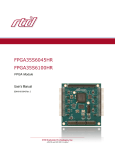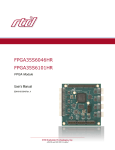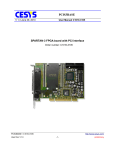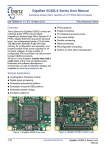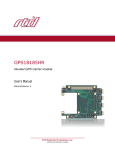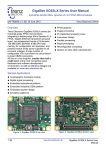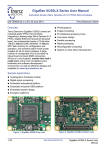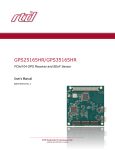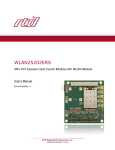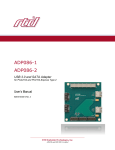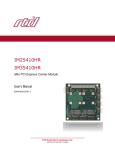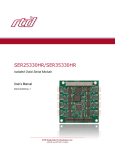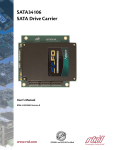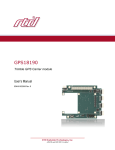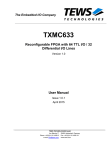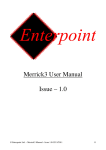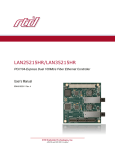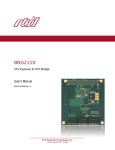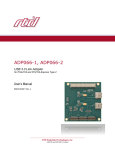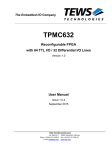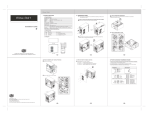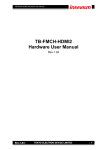Download Hardware Manual - RTD Embedded Technologies, Inc.
Transcript
FPGA35S6045HR FPGA35S6100HR FPGA Module User’s Manual BDM-610010045 Rev. D RTD Embedded Technologies, Inc. AS9100 and ISO 9001 Certified RTD Embedded Technologies, Inc. 103 Innovation Boulevard State College, PA 16803 USA Telephone: 814-234-8087 Fax: 814-234-5218 www.rtd.com [email protected] [email protected] Revision History Rev A Rev B Rev C Rev D Initial Release Corrected pin names in Table 5 on page 13. Corrected FPGA Bank designations in CN4 & CN9: Digital I/O Connector on page 14. Added IDAN connector section. Change IDAN JTAG signals from P2 to P3 in Table 13 on page 18. Updated pictures. Changed JP7 to three-pin. Added User ID jumpers. Added embedded programmer, configuration flash, PCI vendor and device ID. Advanced Analog I/O, Advanced Digital I/O, aAIO, aDIO, a2DIO, Autonomous SmartCal, “Catch the Express”, cpuModule, dspFramework, dspModule, expressMate, ExpressPlatform, HiDANplus, “MIL Value for COTS prices”, multiPort, PlatformBus, and PC/104EZ are trademarks, and “Accessing the Analog World”, dataModule, IDAN, HiDAN, RTD, and the RTD logo are registered trademarks of RTD Embedded Technologies, Inc (formerly Real Time Devices, Inc.). PS/2 is a trademark of International Business Machines Inc. PCI, PCI Express, and PCIe are trademarks of PCI-SIG. PC/104, PC/104-Plus, PCI-104, PCIe/104, PCI/104-Express and 104 are trademarks of the PC/104 Embedded Consortium. All other trademarks appearing in this document are the property of their respective owners. Failure to follow the instructions found in this manual may result in damage to the product described in this manual, or other components of the system. The procedure set forth in this manual shall only be performed by persons qualified to service electronic equipment. Contents and specifications within this manual are given without warranty, and are subject to change without notice. RTD Embedded Technologies, Inc. shall not be liable for errors or omissions in this manual, or for any loss, damage, or injury in connection with the use of this manual. Copyright © 2015 by RTD Embedded Technologies, Inc. All rights reserved. RTD Embedded Technologies, Inc. | www.rtd.com iii FPGA35S6 User’s Manual Table of Contents 1 2 3 4 5 Introduction 7 1.1 Product Overview........................................................................................................................................................................ 7 1.2 Board Features ........................................................................................................................................................................... 7 1.3 Ordering Information ................................................................................................................................................................... 8 1.4 Contact Information .................................................................................................................................................................... 8 1.4.1 Sales Support 8 1.4.2 Technical Support 8 Specifications 9 2.1 Operating Conditions .................................................................................................................................................................. 9 2.2 Electrical Characteristics ............................................................................................................................................................ 9 Board Connection 10 3.1 Board Handling Precautions ..................................................................................................................................................... 10 3.2 Physical Characteristics ............................................................................................................................................................ 10 3.3 Connectors and Jumpers .......................................................................................................................................................... 11 3.3.1 External I/O Connectors 12 CN3: Xilinx JTAG Programming Header 12 CN8: High Speed Digital I/O Connector 13 CN4 & CN9: Digital I/O Connector 14 3.3.2 Bus Connectors 14 CN1 (Top) & CN2 (Bottom): PCIe Connector 14 3.3.3 Jumpers 14 JP1, JP2, JP3, JP4, JP5, & JP6: Pull up/Pull down Jumper 14 JP7: Embedded Programmer Enable 15 JP8: User ID Jumper 15 3.3.1 Solder Jumpers 15 B1: Pull up Voltage 15 B2: Pull up Voltage 15 3.4 Steps for Installing .................................................................................................................................................................... 16 IDAN Connections 17 4.1 Module Handling Precautions ................................................................................................................................................... 17 4.2 Physical Characteristics ............................................................................................................................................................ 17 4.3 Connectors and Jumpers .......................................................................................................................................................... 18 P2 & P3: Digital I/O Connector 18 P4: High Speed Digital I/O Connector 19 4.3.1 Bus Connectors 21 CN1 (Top) & CN2 (Bottom): PCIe Connector 21 4.3.2 Jumpers 21 JP1, JP2, JP3, JP4, JP5, & JP6: Pull up/Pull down Jumper 21 JP7: Embedded Programmer Enable 21 JP8: User ID Jumper 21 4.3.3 Solder Jumpers 21 B1: Pull up Voltage 21 B2: Pull up Voltage 22 4.4 Steps for Installing .................................................................................................................................................................... 23 Functional Description 24 5.2 Configuration Flash ................................................................................................................................................................... 24 5.3 Oscillator ................................................................................................................................................................................... 24 5.4 EEPROM .................................................................................................................................................................................. 24 RTD Embedded Technologies, Inc. | www.rtd.com iv FPGA35S6 User’s Manual 6 5.5 DDR2 SRAM ............................................................................................................................................................................. 24 5.6 Digital I/O .................................................................................................................................................................................. 25 5.7 Embedded Digilent® USB JTAG Programmer ......................................................................................................................... 25 Register Address Space 26 6.1 Identifying the Board ................................................................................................................................................................. 26 6.2 BAR0 – FPGA Example Register Map ..................................................................................................................................... 26 6.2.1 R_ID (Read) 26 6.2.2 R_STATUS (Read) 26 6.2.3 R_EEPROM (Read/Write) 27 6.2.4 R_USER_ID (Read) 27 6.2.5 R_PORT0_IN (Read) 27 6.2.6 R_PORT0_OUT (Write) 27 6.2.7 R_PORT0_DIR (Write) 27 6.2.8 R_PORT1_IN (Read) 27 6.2.9 R_PORT1_OUT (Write) 27 6.2.10 R_PORT1_DIR (Read/Write) 27 6.2.11 R_PORT2L_IN (Read) 27 6.2.12 R_PORT2L_OUT (Write) 27 6.2.13 R_PORT2L_DIR (Read/Write) 27 6.2.14 R_PORT2H_IN (Read) 27 6.2.15 R_PORT2H_OUT (Write) 28 6.2.16 R_PORT2H_DIR (Read/Write) 28 6.2.17 R_DDR_RD_DATA (Read) 28 6.2.18 R_DDR_WR_DATA (Read/Write) 28 6.2.19 R_DDR_ADDR (Read/Write) 28 6.2.20 R_DDR_STATUS (Read) 29 7 Troubleshooting 30 8 Additional Information 31 9 8.1 PC/104 Specifications ............................................................................................................................................................... 31 8.2 PCI and PCI Express Specification .......................................................................................................................................... 31 Limited Warranty RTD Embedded Technologies, Inc. | www.rtd.com 32 v FPGA35S6 User’s Manual Table of Figures Figure 1: Board Dimensions ................................................................................................................................................................................... 10 Figure 2: Board Connections .................................................................................................................................................................................. 11 Figure 3: Bottom Solder Jumper Locations ............................................................................................................................................................ 12 Figure 4: Example 104™Stack ............................................................................................................................................................................... 16 Figure 5: IDAN Dimensions .................................................................................................................................................................................... 17 Figure 6: Example IDAN System ............................................................................................................................................................................ 23 Figure 7: FPGA35S6 Block Diagram ...................................................................................................................................................................... 24 Figure 8: CN4/CN9 Digital I/O Circuitry .................................................................................................................................................................. 25 Table of Tables Table 1: Ordering Options ........................................................................................................................................................................................ 8 Table 2: Operating Conditions .................................................................................................................................................................................. 9 Table 3: Electrical Characteristics ............................................................................................................................................................................ 9 Table 4: CN3 Programming Header ....................................................................................................................................................................... 12 Table 5: CN8 I/O Pin Assignments ......................................................................................................................................................................... 13 Table 6: CN4 I/O Pin Assignments ......................................................................................................................................................................... 14 Table 7: CN9 I/O Pin Assignments ......................................................................................................................................................................... 14 Table 8: Pull up/Pull down Jumper options ............................................................................................................................................................ 14 Table 9: JP7 – Embedded Programmer Enable ..................................................................................................................................................... 15 Table 10: JP8 – User ID Jumper ............................................................................................................................................................................ 15 Table 11: B1 Pull up Voltage .................................................................................................................................................................................. 15 Table 12: B2 Pull up Voltage .................................................................................................................................................................................. 15 Table 13: P2 and P3 Pin Assignments ................................................................................................................................................................... 18 Table 14: P4 Pin Assignments ................................................................................................................................................................................ 19 Table 15: Pull up/Pull down Jumper options .......................................................................................................................................................... 21 Table 16: B1 Pull up Voltage .................................................................................................................................................................................. 21 Table 17: JP8 – User ID Jumper ............................................................................................................................................................................ 21 Table 18: B1 Pull up Voltage .................................................................................................................................................................................. 21 Table 19: B2 Pull up Voltage .................................................................................................................................................................................. 22 Table 20: Identifying the FPGA35S6 ...................................................................................................................................................................... 26 Table 21: FPGA Example Register Map................................................................................................................................................................. 26 RTD Embedded Technologies, Inc. | www.rtd.com vi FPGA35S6 User’s Manual 1 Introduction 1.1 Product Overview The FPGA35S6 series of FPGA boards are designed to provide platform to create any digital I/O that is required for your application. It interfaces with the PCIe bus and features a Xilinx Spartan 6 FPGA with a 27 MHz oscillator and 1Gb of DDR2 SDRAM. There 48 5V tolerant I/O and 40 3.3V tolerant high speed I/O. 1.2 Board Features Xilinx Spartan 6 System level features o XC6SLX45T-2FGG484I 43,661 Logic Cells 2,489 kb of internal RAM 116 18Kb (2088 Kb Max) Block RAM 401 kB Distributed RAM XCF16PFSG48C Configuration Flash o XC6SLX100T-2FGG484I 101,261 Logic Cells 5,800 kb of internal RAM 268 18Kb (4,824 Kb Max) Block RAM 976 kB Distributed RAM XCF32PFSG48C Configuration Flash o RAM hierarchical memory: Each block RAM has two independent ports Programmable Data Width o Integrated Endpoint block for PCI Express o Integrated Memory Controller 1 Gb of DDR2 SDRAM Supports access rates of up to 800Mb/s o Dedicated carry logic for high-speed arithmetic o Abundant logic resources with increased logic capacity Optional shift register or distributed RAM support Efficient 6-input LUTs LUT with dual flip-flops o Four dedicated DLLs for advanced clock control Phase shift input clock by 0, 90, 180, 270 Multiply input clock by 2 to 32 Divide input clock by 1 to 32 Fully supported by Xilinx development system o ISE WebPACK (free download from http://www.xilinx.com) o ISE Design Suite Digital I/O Connectors o 48 5 volt tolerant I/O with ESD protection o 40 3.3 volt tolerant high speed I/O with ESD protection Embedded Digilent® USB JTAG Programmer o Allows programming from the host computer o Compatible with Xilinx tools, including iMpact and ChipScope PCI Express Bus: o PCIe/104 Universal Board Interfaces with Type 1 or Type 2 bus No re-population o Provides 2.5 Gbps in each direction o In-band interrupts and messages o Message Signaled Interrupt (MSI) support RTD Embedded Technologies, Inc. | www.rtd.com 7 FPGA35S6 User’s Manual 1.3 Ordering Information The FPGA35S6 series of FPGA boards is available in the following options: Table 1: Ordering Options Part Number FPGA35S6045HR FPGA35S6100HR IDAN-FPGA35S6045HR IDAN-FPGA35S6100HR Description PCIe/104 Spartan-6 XC6SLX45T User Programmable FPGA Module PCIe/104 Spartan-6 XC6SLX100T User Programmable FPGA Module PCIe/104 Spartan-6 XC6SLX45T User Programmable FPGA Module in IDAN enclosure PCIe/104 Spartan-6 XC6SLX100T User Programmable FPGA Module in IDAN enclosure A Starter Kit is available for any of the options, which includes the appropriate programming cable. Contact RTD Sales for more information. The FPGA35S6 is a general use FPGA module, allowing you to design your own FPGA. It has support for custom oscillator and larger Xilinx Spartan 6 FPGAs. Please contact RTD Embedded Technologies for more information on custom FPGA35S6 products and custom FPGA designs. The Intelligent Data Acquisition Node (IDAN™) building block can be used in just about any combination with other IDAN building blocks to create a simple but rugged 104™ stack. This module can also be incorporated in a custom-built RTD HiDAN™ or HiDANplus High Reliability Intelligent Data Acquisition Node. Contact RTD sales for more information on our high reliability systems. 1.4 Contact Information 1.4.1 SALES SUPPORT For sales inquiries, you can contact RTD Embedded Technologies sales via the following methods: Phone: E-Mail: 1.4.2 1-814-234-8087 [email protected] Monday through Friday, 8:00am to 5:00pm (EST). TECHNICAL SUPPORT If you are having problems with you system, please try the steps in the Troubleshooting section of this manual. For help with this product, or any other product made by RTD, you can contact RTD Embedded Technologies technical support via the following methods: Phone: E-Mail: 1-814-234-8087 Monday through Friday, 8:00am to 5:00pm (EST). [email protected] RTD Embedded Technologies, Inc. | www.rtd.com 8 FPGA35S6 User’s Manual 2 Specifications 2.1 Operating Conditions Table 2: Operating Conditions Symbol Vcc5 Vcc3 Vcc12 Ta Ts RH Parameter 5V Supply Voltage 3.3V Supply Voltage 12V Supply Voltage Operating Temperature Storage Temperature Relative Humidity MTBF Mean Time Before Failure Test Condition Min 4.75 n/a n/a -40 -40 0 Non-Condensing Telcordia Issue 2 30°C, Ground benign, controlled FPGA35S6045HR Max 5.25 n/a n/a +85 +85 90% 2,471,464 Unit V V V C C % Hours 2.2 Electrical Characteristics Table 3: Electrical Characteristics Symbol P Icc Parameter Power Consumption(1) 5V Input Supply Current(1) Test Condition Vcc5 = 5.0V Active PCIe/104 Bus Differential Output Voltage DC Differential TX Impedance Differential Input Voltage DC Differential RX Impedance Electrical Idle Detect Threshold VIH VIH VIL VOH VOL Input High Voltage Input High Voltage Input Low Voltage Output High Voltage Output Low Voltage 5V Output Digital I/O CN4,CN9 CN8 CN4,CN8,CN9 IO = -12mA CN4 CN8,CN9 IO = 12mA CN4 CN8,CN9 CN4,CN8,CN9 DDR2 Interface Access Rate(2) Note: Min Typ 2.5 500 Max Unit W mA 0.8 80 0.175 80 65 1.2 120 1.2 120 175 V Ω V Ω mV 2.0 2.0 -0.5 2.6 0 5.5 3.6 0.8 3.3 0.4 200 V V V V V mA 250 800 Mb/s (1): Typical power consumption based on RTD’s FPGA example. (2): Proving by design, not production tested. For additionally electrical characteristic of the Spartan 6 I/O refer to http://www.xilinx.com RTD Embedded Technologies, Inc. | www.rtd.com 9 FPGA35S6 User’s Manual 3 Board Connection 3.1 Board Handling Precautions To prevent damage due to Electrostatic Discharge (ESD), keep your board in its antistatic bag until you are ready to install it into your system. When removing it from the bag, hold the board at the edges, and do not touch the components or connectors. Handle the board in an antistatic environment, and use a grounded workbench for testing and handling of your hardware. 3.2 Physical Characteristics Weight: Approximately 63.5 g (0.14 lbs.) Dimensions: 90.17 mm L x 95.89 mm W (3.550 in L x 3.775 in W) Figure 1: Board Dimensions RTD Embedded Technologies, Inc. | www.rtd.com 10 FPGA35S6 User’s Manual 3.3 Connectors and Jumpers JP7: Embedded Programmer Enable CN8: High Speed Digital I/O CN9: Digital I/O CN4: Digital I/O JP4, JP5 & JP6: Pull up/Pull down Jumper JP1, JP2 & JP3: Pull up/Pull down Jumper CN3: Programming Header CN1 & CN2: PCIe Connector JP8: User ID Jumper Figure 2: Board Connections RTD Embedded Technologies, Inc. | www.rtd.com 11 FPGA35S6 User’s Manual B2 B1 1 1 Figure 3: Bottom Solder Jumper Locations 3.3.1 EXTERNAL I/O CONNECTORS CN3: Xilinx JTAG Programming Header Connector CN3 provides a connection to the Xilinx JTAG programming header. The pin assignment for CN3 is shown below. This connector header mates with the Xilinx OEM programming cable. Table 4: CN3 Programming Header 3.3V VRef TMS TCK TDO TDI N/C N/C RTD Embedded Technologies, Inc. | www.rtd.com 2 4 6 8 10 12 14 12 1 3 5 7 9 11 13 GND GND GND GND GND GND GND FPGA35S6 User’s Manual CN8: High Speed Digital I/O Connector Connector CN8 provides 40 digital I/O lines, along with a +5V pin and ground pins. These signals are 3.3V tolerant. The signal names reflect the signal names I n the Xilinx UCF file with the device pin out. CN8 is attached to Bank 1, and supports any of the Spartan 6 I/O Standards that use a 3.3V VCCO and no reference voltage. This includes LVTTL, LVCMOS33 input and output, and LVDS_33 input. LVDS output is not supported in Bank 1. Table 5: CN8 I/O Pin Assignments Port2_n[0] Port2_n[1] Port2_n[2] Port2_n[3] GND Port2_n[4] Port2_n[5] Port2_n[6] Port2_n[7] GND Port2_n[8] Port2_n[9] Port2_n[10] Port2_n[11] GND Port2_n[12] Port2_n[13] Port2_n[14] Port2_n[15] GND Port2_n[16] Port2_n[17] Port2_n[18] Port2_n[19] GND RTD Embedded Technologies, Inc. | www.rtd.com 2 4 6 8 10 12 14 16 18 20 22 24 26 28 30 32 34 36 38 40 42 44 46 48 50 1 3 5 7 9 11 13 15 17 19 21 23 25 27 29 31 33 35 37 39 41 43 45 47 49 13 Port2_p[0] Port2_p[1] Port2_p[2] Port2_p[3] GND Port2_p[4] Port2_p[5] Port2_p[6] Port2_p[7] GND Port2_p[8] Port2_p[9] Port2_p[10] Port2_p[11] GND Port2_p[12] Port2_p[13] Port2_p[14] Port2_p[15] GND Port2_p[16] Port2_p[17] Port2_p[18] Port2_p[19] +5V FPGA35S6 User’s Manual CN4 & CN9: Digital I/O Connector Connectors CN4 and CN9 each provide 24 digital I/O lines, along with a +5V pin and ground pins. All I/O have pull up/pull down resistors that are controlled by jumper options, also shown in the table. These signals are 5V tolerant. The signal names reflect the signal names I n the Xilinx UCF file with the device pin out. CN4 and CN9 are attached to Bank 2 and 0 respectively, and support any of the Spartan 6 I/O Standards that use a 3.3V VCCO and no reference voltage. This includes LVTTL, LVCMOS33, and LVDS_33 input and output. 3.3.2 Table 6: CN4 I/O Pin Assignments Table 7: CN9 I/O Pin Assignments GND GND GND GND GND GND GND GND GND GND GND GND GND GND GND GND GND GND GND GND GND GND GND GND GND GND GND GND GND GND GND GND GND GND GND GND GND GND GND GND GND GND GND GND GND GND GND GND GND GND 2 4 6 8 10 12 14 16 18 20 22 24 26 28 30 32 34 36 38 40 42 44 46 48 50 1 3 5 7 9 11 13 15 17 19 21 23 25 27 29 31 33 35 37 39 41 43 45 47 49 port0_p[0] port0_n[0] port0_p[1] port0_n[1] port0_p[2] port0_n[2] port0_p[3] port0_n[3] port0_p[4] port0_n[4] port0_p[5] port0_n[5] port0_p[6] port0_n[6] port0_p[7] port0_n[7] port0_p[8] port0_n[8] port0_p[9] port0_n[9] port0_p[10] port0_n[10] port0_p[11] port0_n[11] +5V JP1 JP2 JP3 2 4 6 8 10 12 14 16 18 20 22 24 26 28 30 32 34 36 38 40 42 44 46 48 50 1 3 5 7 9 11 13 15 17 19 21 23 25 27 29 31 33 35 37 39 41 43 45 47 49 port1_p[0] port1_n[0] port1_p[1] port1_n[1] port1_p[2] port1_n[2] port1_p[3] port1_n[3] port1_p[4] port1_n[4] port1_p[5] port1_n[5] port1_p[6] port1_n[6] port1_p[7] port1_n[7] port1_p[8] port1_n[8] port1_p[9] port1_n[9] port1_p[10] port1_n[10] port1_p[11] port1_n[11] +5V JP4 JP5 JP6 BUS CONNECTORS CN1 (Top) & CN2 (Bottom): PCIe Connector The PCIe connector is the connection to the system CPU. The position and pin assignments are compliant with the PCI/104-Express Specification. (See PC/104 Specifications on page 31) The FPGA35S6 is a “Universal” board, and can connect to either a Type 1 or Type 2 PCIe/104 connector. 3.3.3 JUMPERS JP1, JP2, JP3, JP4, JP5, & JP6: Pull up/Pull down Jumper JP1, JP2, JP3, JP4, JP5, and JP6 are 3-pin two position jumpers that are used to set pull up or pull downs options on the I/O signal lines of CN4 and C5. Refer to Table 6 and Table 7 to determine which I/O pins are effected by each jumper. Table 8: Pull up/Pull down Jumper options Setting 1-2 2-3 No Jumper RTD Embedded Technologies, Inc. | www.rtd.com Description I/O is pulled up to 3.3V or 5V (Set by B1 and B2) I/O is pulled down to GND I/O has no pull up/pull down 14 FPGA35S6 User’s Manual JP7: Embedded Programmer Enable This jumper is used to enable the embedded programmer to the JTAG chain. See Section 5.7 on page 25 for more details. The board can be programmed from and external programmer with this jumper in either position. Table 9: JP7 – Embedded Programmer Enable Setting 1-2 2-3 or open Description Enabled embedded programmer Disables embedded programmer JP8: User ID Jumper The User ID Jumper is a four position, user defined jumper block. The jumpers can be read by the FPGA. An installed jumper results in a logic low, and an open jumper results in a logic high. Table 10: JP8 – User ID Jumper Position 1-2 3-4 5-6 7-8 3.3.1 Description User ID bit 0 User ID bit 1 User ID bit 2 User ID bit 3 SOLDER JUMPERS B1: Pull up Voltage Solder jumper B1 are used to set the pull up voltage for JP1, JP2 and JP3. Table 11: B1 Pull up Voltage Setting 1-2 2-3 Description Sets Pull up voltage to 3.3V Sets Pull up voltage to 5V B2: Pull up Voltage Solder jumper B1 are used to set the pull up voltage for JP4, JP5 and JP6. Table 12: B2 Pull up Voltage Setting 1-2 2-3 RTD Embedded Technologies, Inc. | www.rtd.com Description Sets Pull up voltage to 3.3V Sets Pull up voltage to 5V 15 FPGA35S6 User’s Manual 3.4 Steps for Installing 1. 2. 3. 4. 5. 6. 7. 8. 9. 10. 11. 12. Always work at an ESD protected workstation, and wear a grounded wrist-strap. Turn off power to the PC/104 system or stack. Select and install stand-offs to properly position the module on the stack. Remove the module from its anti-static bag. Check that pins of the bus connector are properly positioned. Check the stacking order; make sure all of the busses used by the peripheral cards are connected to the cpuModule. Hold the module by its edges and orient it so the bus connector pins line up with the matching connector on the stack. Gently and evenly press the module onto the PC/104 stack. If any boards are to be stacked above this module, install them. Attach any necessary cables to the PC/104 stack. Re-connect the power cord and apply power to the stack. Boot the system and verify that all of the hardware is working properly. Figure 4: Example 104™Stack RTD Embedded Technologies, Inc. | www.rtd.com 16 FPGA35S6 User’s Manual 4 IDAN Connections 4.1 Module Handling Precautions To prevent damage due to Electrostatic Discharge (ESD), keep your module in its antistatic bag until you are ready to install it into your system. When removing it from the bag, hold the module by the aluminum enclosure, and do not touch the components or connectors. Handle the module in an antistatic environment, and use a grounded workbench for testing and handling of your hardware. 4.2 Physical Characteristics Weight: Approximately 0.42 Kg (0.92 lbs.) Dimensions: 152mm L x 130mm W x 34mm H (5.983" L x 5.117" W x 1.339" H) 1.339” [34mm] Front 5.983” [152mm] 5.117” [130mm] Back Figure 5: IDAN Dimensions RTD Embedded Technologies, Inc. | www.rtd.com 17 FPGA35S6 User’s Manual 4.3 Connectors and Jumpers P2 & P3: Digital I/O Connector Connector Part #: VALCONN HDB-62S Mating Connector: VALCONN HDB-62P Connectors P2 and P3 each provide 24 digital I/O lines, along with a +5V pin and ground pins. All I/O have pull up/pull down resistors that are controlled by jumper options, also shown in the table. These signals are 5V tolerant. The signal names reflect the signal names I n the Xilinx UCF file with the device pin out. P2 and P3 are attached to Bank 2 and 0 respectively, and support any of the Spartan 6 I/O Standards that use a 3.3V VCCO and no reference voltage. This includes LVTTL, LVCMOS33, and LVDS_33 input and output. Connector P2 also provides a connection to the Xilinx JTAG programming header. This connector header mates with the Xilinx OEM programming cable through an adapter cable. The adapter cable is provided when purchasing the Starter Kit. Table 13: P2 and P3 Pin Assignments Row 1 1 IDAN P2 Pin Row 2 Row 3 22 43 2 23 44 3 24 45 4 25 46 5 26 47 6 27 48 7 28 49 8 29 50 9 30 51 10 31 52 11 32 53 12 33 54 13 34 55 14 35 56 15 Signal port0_p[0] GND port0_n[0] GND port0_p[1] GND port0_n[1] GND port0_p[2] GND port0_n[2] GND port0_p[3] GND port0_n[3] GND port0_p[4] GND port0_n[4] GND port0_p[5] GND port0_n[5] GND port0_p[6] GND port0_n[6] GND port0_p[7] GND port0_n[7] GND port0_p[8] GND port0_n[8] GND port0_p[9] GND port0_n[9] GND port0_p[10] GND port0_n[10] Pull Jmpr JP1 JP2 JP3 RTD Embedded Technologies, Inc. | www.rtd.com CN4 Pin 1 2 3 4 5 6 7 8 9 10 11 12 13 14 15 16 17 18 19 20 21 22 23 24 25 26 27 28 29 30 31 32 33 34 35 36 37 38 39 40 41 42 43 Row 1 1 IDAN P3 Pin Row 2 Row 3 22 43 2 23 44 3 24 45 4 25 46 5 26 47 6 27 48 7 28 49 8 29 50 9 30 51 10 31 52 11 32 53 12 33 54 13 34 55 14 35 56 15 18 Signal port1_p[0] GND port1_n[0] GND port1_p[1] GND port1_n[1] GND port1_p[2] GND port1_n[2] GND port1_p[3] GND port1_n[3] GND port1_p[4] GND port1_n[4] GND port1_p[5] GND port1_n[5] GND port1_p[6] GND port1_n[6] GND port1_p[7] GND port1_n[7] GND port1_p[8] GND port1_n[8] GND port1_p[9] GND port1_n[9] GND port1_p[10] GND port1_n[10] Pull Jmpr JP4 JP5 JP6 C9 Pin 1 2 3 4 5 6 7 8 9 10 11 12 13 14 15 16 17 18 19 20 21 22 23 24 25 26 27 28 29 30 31 32 33 34 35 36 37 38 39 40 41 42 43 FPGA35S6 User’s Manual Table 13: P2 and P3 Pin Assignments Row 1 IDAN P2 Pin Row 2 Row 3 36 57 16 37 58 17 38 59 18 39 60 19 40 61 20 41 62 21 42 Signal GND port0_p[11] GND port0_n[11] GND +5V GND Reserved Reserved Reserved Reserved Reserved Reserved Reserved Reserved Reserved Reserved Reserved Reserved Pull Jmpr CN4 Pin 44 45 46 47 48 49 50 Row 1 IDAN P3 Pin Row 2 Row 3 36 57 16 37 58 17 38 59 18 39 60 19 40 61 20 41 62 21 42 Signal GND port1_p[11] GND port1_n[11] GND +5V GND Reserved jtag_vref GND jtag_tms GND_TCK jtag_tck GND jtag_tdo GND jtag_tdi Reserved Reserved Pull Jmpr C9 Pin 44 45 46 47 48 49 50 CN3.2 CN3.3 CN3.4 CN3.5 CN3.6 CN3.7 CN3.8 CN3.9 CN3.10 P4: High Speed Digital I/O Connector Connector Part #: VALCONN HDB-62S Mating Connector: VALCONN HDB-62P Connector P4 provides 40 digital I/O lines, along with a +5V pin and ground pins. These signals are 3.3V tolerant. The signal names reflect the signal names I n the Xilinx UCF file with the device pin out. P4 is attached to Bank 1, and supports any of the Spartan 6 I/O Standards that use a 3.3V VCCO and no reference voltage. This includes LVTTL, LVCMOS33 input and output, and LVDS_33 input. LVDS output is not supported in Bank 1. Table 14: P4 Pin Assignments Row 1 1 IDAN P4 Pin Row 2 Row 3 22 43 2 23 44 3 24 45 4 25 46 5 26 47 6 27 48 7 28 49 8 29 50 RTD Embedded Technologies, Inc. | www.rtd.com Signal Port2_p[0] Port2_n[0] Port2_p[1] Port2_n[1] Port2_p[2] Port2_n[2] Port2_p[3] Port2_n[3] GND GND Port2_p[4] Port2_n[4] Port2_p[5] Port2_n[5] Port2_p[6] Port2_n[6] Port2_p[7] Port2_n[7] GND GND Port2_p[8] Port2_n[8] Port2_p[9] Port2_n[9] 19 C8 Pin 1 2 3 4 5 6 7 8 9 10 11 12 13 14 15 16 17 18 19 20 21 22 23 24 FPGA35S6 User’s Manual Table 14: P4 Pin Assignments Row 1 9 IDAN P4 Pin Row 2 Row 3 30 51 10 31 52 11 32 53 12 33 54 13 34 55 14 35 56 15 36 57 16 37 58 17 38 59 18 39 60 19 40 61 20 41 62 21 42 RTD Embedded Technologies, Inc. | www.rtd.com Signal Port2_p[10] Port2_n[10] Port2_p[11] Port2_n[11] GND GND Port2_p[12] Port2_n[12] Port2_p[13] Port2_n[13] Port2_p[14] Port2_n[14] Port2_p[15] Port2_n[15] GND GND Port2_p[16] Port2_n[16] Port2_p[17] Port2_n[17] Port2_p[18] Port2_n[18] Port2_p[19] Port2_n[19] +5V GND Reserved Reserved Reserved Reserved Reserved Reserved Reserved Reserved Reserved Reserved Reserved Reserved 20 C8 Pin 25 26 27 28 29 30 31 32 33 34 35 36 37 38 39 40 41 42 43 44 45 46 47 48 49 50 FPGA35S6 User’s Manual 4.3.1 BUS CONNECTORS CN1 (Top) & CN2 (Bottom): PCIe Connector The PCIe connector is the connection to the system CPU. The position and pin assignments are compliant with the PCI/104-Express Specification. (See PC/104 Specifications on page 31) The FPGA35S6 is a “Universal” board, and can connect to either a Type 1 or Type 2 PCIe/104 connector. 4.3.2 JUMPERS JP1, JP2, JP3, JP4, JP5, & JP6: Pull up/Pull down Jumper JP1, JP2, JP3, JP4, JP5, and JP6 are 3-pin two position jumpers that are used to set pull up or pull downs options on the I/O signal lines of CN4 and C5. Refer to Table 13 and Table 14 to determine which I/O pins are effected by each jumper. Table 15: Pull up/Pull down Jumper options Setting 1-2 2-3 No Jumper Description I/O is pulled up to 3.3V or 5V (Set by B1 and B2) I/O is pulled down to GND I/O has no pull up/pull down JP7: Embedded Programmer Enable This jumper is used to enable the embedded programmer to the JTAG chain. See Section 5.7 on page 25 for more details. The board can be programmed from and external programmer with this jumper in either position. Table 16: B1 Pull up Voltage Setting 1-2 2-3 or open Description Enabled embedded programmer Disables embedded programmer JP8: User ID Jumper The User ID Jumper is a four position, user defined jumper block. The jumpers can be read by the FPGA. An installed jumper results in a logic low, and an open jumper results in a logic high. Table 17: JP8 – User ID Jumper Position 1-2 3-4 5-6 7-8 4.3.3 Description User ID bit 0 User ID bit 1 User ID bit 2 User ID bit 3 SOLDER JUMPERS B1: Pull up Voltage Solder jumper B1 are used to set the pull up voltage for JP1, JP2 and JP3. Table 18: B1 Pull up Voltage Setting 1-2 2-3 RTD Embedded Technologies, Inc. | www.rtd.com Description Sets Pull up voltage to 3.3V Sets Pull up voltage to 5V 21 FPGA35S6 User’s Manual B2: Pull up Voltage Solder jumper B1 are used to set the pull up voltage for JP4, JP5 and JP6. Table 19: B2 Pull up Voltage Setting 1-2 2-3 RTD Embedded Technologies, Inc. | www.rtd.com Description Sets Pull up voltage to 3.3V Sets Pull up voltage to 5V 22 FPGA35S6 User’s Manual 4.4 Steps for Installing 1. 2. 3. 4. 5. 6. 7. 8. 9. 10. 11. 12. Always work at an ESD protected workstation, and wear a grounded wrist-strap. Turn off power to the IDAN system. Remove the module from its anti-static bag. Check that pins of the bus connector are properly positioned. Check the stacking order; make sure all of the busses used by the peripheral cards are connected to the cpuModule. Hold the module by its edges and orient it so the bus connector pins line up with the matching connector on the stack. Gently and evenly press the module onto the IDAN system. If any boards are to be stacked above this module, install them. Finish assembling the IDAN stack by installing screws of an appropriate length. Attach any necessary cables to the IDAN system. Re-connect the power cord and apply power to the stack. Boot the system and verify that all of the hardware is working properly. Figure 6: Example IDAN System RTD Embedded Technologies, Inc. | www.rtd.com 23 FPGA35S6 User’s Manual 5 Functional Description 5.1 Block Diagram The Figure below shows the functional block diagram of the FPGA35S6. The various parts of the block diagram are discussed in the following sections. X2 Level Shifter PCIe x1 Link Xilinx Spartan 6 EEPROM High Speed Digital I/O CN8 PCIe Bus DDR2 SRAM Digital I/O CN4 and CN9 X2 Oscillator Figure 7: FPGA35S6 Block Diagram 5.2 Configuration Flash The FPGA35S6 includes a Configuration Flash that is sized for the FPGA. At power up, the FPGA design is loaded from the Configuration Flash. The Configuration Flash can be programmed through either the Embedded Digilent® USB JTAG Programmer, or CN3: Xilinx JTAG Programming Header. 5.3 Oscillator The FPGA35S6 features a 27 MHz oscillator for clock based operations in the FPGA. 5.4 EEPROM The FPGA35S6 features a 256 x 16 SPI EEPROM, ATMEL AT93C66A. For information on the AT93C66A refer to http://www.atmel.com/ 5.5 DDR2 SRAM The FPGA35S6 features a 1Gb DDR2 SRAM, MT47H64M16HR 25E. This is interface to the Spartan 6 FPGA using Xilinx Memory Interface Generators (MIG) core. The example FPGA code has demonstrated how to use this core in a FPGA design. RTD Embedded Technologies, Inc. | www.rtd.com 24 FPGA35S6 User’s Manual 5.6 Digital I/O The FPGA35S6 digital I/O on connectors CN4 and CN9 use the circuitry shown below to level shift the input voltage from 5V to 3.3V allowing the I/O on these connectors to be 5V tolerant. CN4/CN9 33Ω Digital I/O Xilinx Spartan 6 Level Shifter 10KΩ +5V/3.3V Figure 8: CN4/CN9 Digital I/O Circuitry 5.7 Embedded Digilent® USB JTAG Programmer This FPGA board includes an embedded Digilent ® JTAG programming module. It connects to the host through the USB connections on the PCIe Bus connectors. A USB hub is also provided for lane repopulation. The programming module is compatible with all Xilinx tools, including iMpact and ChipScope (www.xilinx.com). It is also supported by Digilent’s Adept software package (www.digilentinc.com). In order to use the embedded programmer, JP7 must be installed in the 1-2 position. This attaches the programmer to the JTAG chain. CN3 can always be used regardless of whether or not JP1 is installed. The embedded programmer has a user string of “RTD” followed by the serial number of the board. This can be used to differentiate the programmers if there are multiple boards in the system. RTD Embedded Technologies, Inc. | www.rtd.com 25 FPGA35S6 User’s Manual 6 Register Address Space This is the register address space for the example FPGA that is given with the FPGA35S6. 6.1 Identifying the Board The FPGA35S6 Example shows up in standard PCI Configuration space as a PCI device. It can be positively identified as shown in the Table below. Table 20: Identifying the FPGA35S6 Configuration Space Offset 0x00 0x02 Register Description Vendor ID Device ID Value 0x1435 0x5800 6.2 BAR0 – FPGA Example Register Map Table 21: FPGA Example Register Map Offset 0x00 0x04 0x08 0x0C 0x10 0x14 0x18 0x20 0x24 0x28 0x30 0x34 0x38 0x40 0x44 0x48 0x50 0x54 0x58 0x5C 0x60 0x64 6.2.1 0x03 0x02 R_ID R_STATUS R_EEPROM R_USER_ID R_PORT0_IN R_PORT0_OUT R_PORT0_DIR R_PORT1_IN R_PORT1_OUT R_PORT1_DIR R_PORT2L_IN R_PORT2L_OUT R_PORT2L_DIR R_PORT2H_IN R_PORT2H_OUT R_PORT2H_DIR R_DDR_RD_DATA R_DDR_WR_DATA R_DDR_ADDR R_DDR_STATUS R_CLK_27_1 R_CLK_27_2 0x01 0x00 R_ID (READ) This is a register that identifies the board. 0x12345678 is the identification of the example code 6.2.2 R_STATUS (READ) This is a status register for power good (pgood) for the power supplies and serial out from the EEPROM B0: EEPROM Serial out B4: 1.2V pgood RTD Embedded Technologies, Inc. | www.rtd.com 26 FPGA35S6 User’s Manual B5: 1.8V pgood B6: 3.3V pgood 6.2.3 R_EEPROM (READ/WRITE) This register has the outputs to the EEPROM. B0: EEPROM Serial Clock B1: EEPROM Serial Input B2: EEPROM Chip Select 6.2.4 R_USER_ID (READ) This register shows the status of the User ID Jumpers B0: User ID 0 Jumper. 0 = Open, 1 = Closed B1: User ID 1 Jumper. 0 = Open, 1 = Closed B2: User ID 2 Jumper. 0 = Open, 1 = Closed B3: User ID 3 Jumper. 0 = Open, 1 = Closed 6.2.5 R_PORT0_IN (READ) This is the input register for the port0. This reads the current value the I/O. 6.2.6 R_PORT0_OUT (WRITE) This is the output register for the port0. The value to be output, direction must be set to output. 6.2.7 R_PORT0_DIR (WRITE) This is the direction register for port0. Indicates the direction of each pin ‘0’ = input ‘1’ = output 6.2.8 R_PORT1_IN (READ) This is the input register for the port1. This reads the current value the I/O. 6.2.9 R_PORT1_OUT (WRITE) This is the output register for the port1. The value to be output, direction must be set to output. 6.2.10 R_PORT1_DIR (READ/WRITE) This is the direction register for port1. Indicates the direction of each pin ‘0’ = input ‘1’ = output 6.2.11 R_PORT2L_IN (READ) This is the input register for the port2 low, port2_[0]…port2_[15]. This reads the current value the I/O. 6.2.12 R_PORT2L_OUT (WRITE) This is the output register for the port2 low, port2_[0]…port2_[15]. The value to be output, direction must be set to output. 6.2.13 R_PORT2L_DIR (READ/WRITE) This is the direction register for port2 low, port2_[0]…port2_[15]. Indicates the direction of each pin ‘0’ = input ‘1’ = output 6.2.14 R_PORT2H_IN (READ) This is the input register for the port2 high, port2_[16]…port2_[19]. This reads the current value the I/O. RTD Embedded Technologies, Inc. | www.rtd.com 27 FPGA35S6 User’s Manual 6.2.15 R_PORT2H_OUT (WRITE) This is the output register for the port2 high, port2_[16]…port2_[19]. The value to be output, direction must be set to output. 6.2.16 R_PORT2H_DIR (READ/WRITE) This is the direction register for port2 high, port2_[16]…port2_[19]. Indicates the direction of each pin ‘0’ = input ‘1’ = output 6.2.17 R_DDR_RD_DATA (READ) Reads the data of the DDR2 SRAM at R_DDR_ADDR location A read is performed by writing address to R_DDR_ADDR. 6.2.18 R_DDR_WR_DATA (READ/WRITE) Writes data in registry to location R_DDR_ADDR of the DDR2 SRAM 6.2.19 R_DDR_ADDR (READ/WRITE) Address pointer of the DDR2 SRAM. RTD Embedded Technologies, Inc. | www.rtd.com 28 FPGA35S6 User’s Manual 6.2.20 R_DDR_STATUS (READ) This is a status register for the DDR2 memory interface. B0: Read error B1: Read overflow B2: Read empty B3: Read full B4: Write error B5: Write underrun B6: Write empty B7: Write full B[14:8]: Read count B[22:16]: Write count B[24]: Command full B[25]: Command empty B[31]: Calibration done RTD Embedded Technologies, Inc. | www.rtd.com 29 FPGA35S6 User’s Manual 7 Troubleshooting If you are having problems with your system, please try the following initial steps: Simplify the System – Remove modules one at a time from your system to see if there is a specific module that is causing a problem. Perform you troubleshooting with the least number of modules in the system possible. Swap Components – Try replacing parts in the system one at a time with similar parts to determine if a part is faulty or if a type of part is configured incorrectly. If problems persist, or you have questions about configuring this product, contact RTD Embedded Technologies via the following methods: Phone: E-Mail: +1-814-234-8087 [email protected] Be sure to check the RTD web site (http://www.rtd.com) frequently for product updates, including newer versions of the board manual and application software. RTD Embedded Technologies, Inc. | www.rtd.com 30 FPGA35S6 User’s Manual 8 Additional Information 8.1 PC/104 Specifications A copy of the latest PC/104 specifications can be found on the webpage for the PC/104 Embedded Consortium: www.pc104.org 8.2 PCI and PCI Express Specification A copy of the latest PCI and PCI Express specifications can be found on the webpage for the PCI Special Interest Group: www.pcisig.com RTD Embedded Technologies, Inc. | www.rtd.com 31 FPGA35S6 User’s Manual 9 Limited Warranty RTD Embedded Technologies, Inc. warrants the hardware and software products it manufactures and produces to be free from defects in materials and workmanship for one year following the date of shipment from RTD Embedded Technologies, Inc. This warranty is limited to the original purchaser of product and is not transferable. During the one year warranty period, RTD Embedded Technologies will repair or replace, at its option, any defective products or parts at no additional charge, provided that the product is returned, shipping prepaid, to RTD Embedded Technologies. All replaced parts and products become the property of RTD Embedded Technologies. Before returning any product for repair, customers are required to contact the factory for a Return Material Authorization (RMA) number. This limited warranty does not extend to any products which have been damaged as a result of accident, misuse, abuse (such as: use of incorrect input voltages, improper or insufficient ventilation, failure to follow the operating instructions that are provided by RTD Embedded Technologies, “acts of God” or other contingencies beyond the control of RTD Embedded Technologies), or as a result of service or modification by anyone other than RTD Embedded Technologies. Except as expressly set forth above, no other warranties are expressed or implied, including, but not limited to, any implied warranties of merchantability and fitness for a particular purpose, and RTD Embedded Technologies expressly disclaims all warranties not stated herein. All implied warranties, including implied warranties for merchantability and fitness for a particular purpose, are limited to the duration of this warranty. In the event the product is not free from defects as warranted above, the purchaser's sole remedy shall be repair or replacement as provided above. Under no circumstances will RTD Embedded Technologies be liable to the purchaser or any user for any damages, including any incidental or consequential damages, expenses, lost profits, lost savings, or other damages arising out of the use or inability to use the product. Some states do not allow the exclusion or limitation of incidental or consequential damages for consumer products, and some states do not allow limitations on how long an implied warranty lasts, so the above limitations or exclusions may not apply to you. This warranty gives you specific legal rights, and you may also have other rights which vary from state to state. RTD Embedded Technologies, Inc. | www.rtd.com 32 FPGA35S6 User’s Manual RTD Embedded Technologies, Inc. 103 Innovation Boulevard State College, PA 16803 USA Telephone: 814-234-8087 Fax: 814-234-5218 www.rtd.com [email protected] [email protected] Copyright 2015 by RTD Embedded Technologies, Inc. All rights reserved.

































